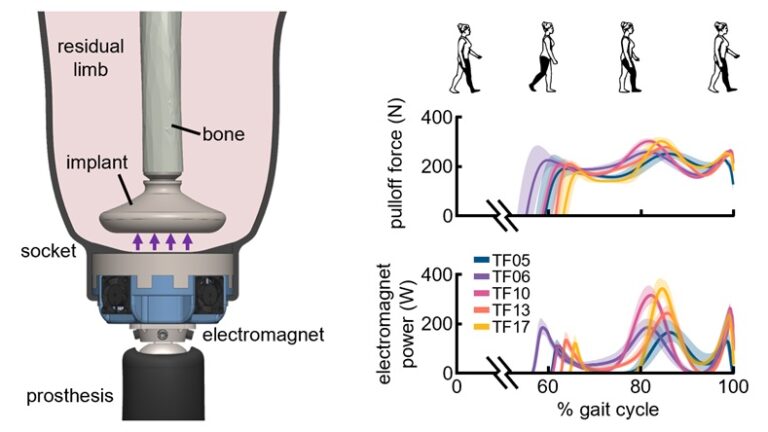Current socket-based methods of prosthetic limb attachment are responsible for many of the dominant problems reported by persons with amputation, primarily due to the reliance on soft tissue for transmitting load. In this work, we introduce a new paradigm for attachment via electromagnetic attraction between a bone-anchored ferromagnetic implant and an external electromagnet. This would allow suspension loads to be transmitted directly to the bone without stressing the soft tissues. Our objective was to develop a design framework for electromagnetic attachment, and to evaluate this framework in the context of transfemoral amputation.
For the transfemoral amputation level, we used inverse dynamics based on the biomechanics of persons with amputation to calculate the forces required to suspend a knee-ankle-foot prosthesis during gait. We then designed an implant and surgical methodology using cadaveric dissections. Through simulations in the electromagnetic simulation software JMAG, we created an electromagnet specifically for this implant that could produce the required suspension forces. These simulations were validated against benchtop testing of a custom-built electromagnet.
The physical electromagnet matched simulations, and our design framework produced an implant and electromagnet that could feasibly suspend a knee-ankle-foot prosthesis during short walking bouts. We estimate that electromagnetic suspension for gait would require 33 W of average power, resulting in temperatures at the skin increasing by 2.3℃ and 15.4℃ relative to ambient after 200 and 1000 continuous steps, respectively. While future work will focus on optimizing this system to reduce heating during long bouts, these initial results show promise for this electromagnetic attachment paradigm that has the potential to increase comfort and improve residual limb health for persons with amputation.

